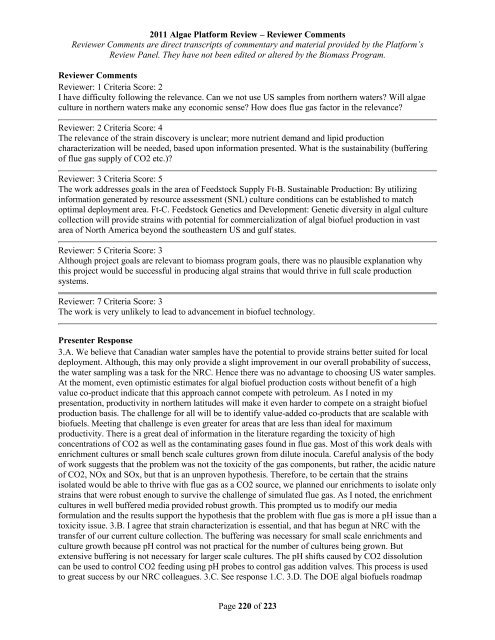Reviewer Comments - EERE
Reviewer Comments - EERE
Reviewer Comments - EERE
Create successful ePaper yourself
Turn your PDF publications into a flip-book with our unique Google optimized e-Paper software.
2011 Algae Platform Review – <strong>Reviewer</strong> <strong>Comments</strong><br />
<strong>Reviewer</strong> <strong>Comments</strong> are direct transcripts of commentary and material provided by the Platform’s<br />
Review Panel. They have not been edited or altered by the Biomass Program.<br />
<strong>Reviewer</strong> <strong>Comments</strong><br />
<strong>Reviewer</strong>: 1 Criteria Score: 2<br />
I have difficulty following the relevance. Can we not use US samples from northern waters? Will algae<br />
culture in northern waters make any economic sense? How does flue gas factor in the relevance?<br />
<strong>Reviewer</strong>: 2 Criteria Score: 4<br />
The relevance of the strain discovery is unclear; more nutrient demand and lipid production<br />
characterization will be needed, based upon information presented. What is the sustainability (buffering<br />
of flue gas supply of CO2 etc.)?<br />
<strong>Reviewer</strong>: 3 Criteria Score: 5<br />
The work addresses goals in the area of Feedstock Supply Ft-B. Sustainable Production: By utilizing<br />
information generated by resource assessment (SNL) culture conditions can be established to match<br />
optimal deployment area. Ft-C. Feedstock Genetics and Development: Genetic diversity in algal culture<br />
collection will provide strains with potential for commercialization of algal biofuel production in vast<br />
area of North America beyond the southeastern US and gulf states.<br />
<strong>Reviewer</strong>: 5 Criteria Score: 3<br />
Although project goals are relevant to biomass program goals, there was no plausible explanation why<br />
this project would be successful in producing algal strains that would thrive in full scale production<br />
systems.<br />
<strong>Reviewer</strong>: 7 Criteria Score: 3<br />
The work is very unlikely to lead to advancement in biofuel technology.<br />
Presenter Response<br />
3.A. We believe that Canadian water samples have the potential to provide strains better suited for local<br />
deployment. Although, this may only provide a slight improvement in our overall probability of success,<br />
the water sampling was a task for the NRC. Hence there was no advantage to choosing US water samples.<br />
At the moment, even optimistic estimates for algal biofuel production costs without benefit of a high<br />
value co-product indicate that this approach cannot compete with petroleum. As I noted in my<br />
presentation, productivity in northern latitudes will make it even harder to compete on a straight biofuel<br />
production basis. The challenge for all will be to identify value-added co-products that are scalable with<br />
biofuels. Meeting that challenge is even greater for areas that are less than ideal for maximum<br />
productivity. There is a great deal of information in the literature regarding the toxicity of high<br />
concentrations of CO2 as well as the contaminating gases found in flue gas. Most of this work deals with<br />
enrichment cultures or small bench scale cultures grown from dilute inocula. Careful analysis of the body<br />
of work suggests that the problem was not the toxicity of the gas components, but rather, the acidic nature<br />
of CO2, NOx and SOx, but that is an unproven hypothesis. Therefore, to be certain that the strains<br />
isolated would be able to thrive with flue gas as a CO2 source, we planned our enrichments to isolate only<br />
strains that were robust enough to survive the challenge of simulated flue gas. As I noted, the enrichment<br />
cultures in well buffered media provided robust growth. This prompted us to modify our media<br />
formulation and the results support the hypothesis that the problem with flue gas is more a pH issue than a<br />
toxicity issue. 3.B. I agree that strain characterization is essential, and that has begun at NRC with the<br />
transfer of our current culture collection. The buffering was necessary for small scale enrichments and<br />
culture growth because pH control was not practical for the number of cultures being grown. But<br />
extensive buffering is not necessary for larger scale cultures. The pH shifts caused by CO2 dissolution<br />
can be used to control CO2 feeding using pH probes to control gas addition valves. This process is used<br />
to great success by our NRC colleagues. 3.C. See response 1.C. 3.D. The DOE algal biofuels roadmap<br />
Page 220 of 223




